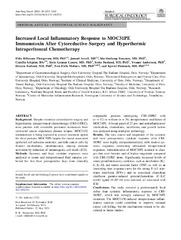Increased Local Inflammatory Response to MOC31PE Immunotoxin After Cytoreductive Surgery and Hyperthermic Intraperitoneal Chemotherapy
Permanent link
https://hdl.handle.net/10037/22109Date
2021-05-21Type
Journal articleTidsskriftartikkel
Peer reviewed
Author
Thorgersen, Ebbe Billmann; Asvall, Jørund; Frøysnes, Ida Storhaug; Schjalm, Camilla; Larsen, Stein Gunnar; Dueland, Svein; Andersson, Yvonne; Fodstad, Øystein; Mollnes, Tom Eirik; Flatmark, KjerstiAbstract
Methods - Systemic and local cytokine responses were analyzed in serum and intraperitoneal fluid samples collected the first three postoperative days from clinically comparable patients undergoing CRS-HIPEC with (n = 12) or without (n = 26) intraperitoneal instillation of MOC31PE. A broad panel of 27 pro- and antiinflammatory interleukins, chemokines, interferons, and growth factors was analyzed using multiplex technology.
Results - The time course and magnitude of the systemic and local postoperative cytokine response after CRS-HIPEC were highly compartmentalized, with modest systemic responses contrasting substantial intraperitoneal responses. Administration of MOC31PE resulted in changes that were broader and of higher magnitude compared with CRS-HIPEC alone. Significantly increased levels of innate proinflammatory cytokines, such as interleukin (IL)-6, IL-1β, and tumor necrosis factor (TNF) as well as an interesting time response curve for the strong T-cell stimulator interferon (IFN)-γ and its associated chemokine interferon gamma-induced protein/chemokine (C-X-C motif) ligand 10 (IP-10) were detected, all associated with ICD.
Conclusions - Our study revealed a predominately local rather than systemic inflammatory response to CRS-HIPEC, which was strongly enhanced by MOC31PE treatment. The MOC31PE-induced intraperitoneal inflammatory reaction could contribute to improve remnant cancer cell killing, but the mechanisms remain to be elucidated in future studies.


 English
English norsk
norsk